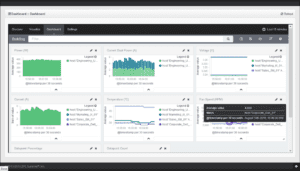
When your car needs new tires, or some other repair, (AND YOU KNOW IT) do you wait until you get a flat on the freeway, or break down and need a tow? Or do you (PROACTIVELY) take it to the shop for new tires or repairs before something happens that ends up costing you big bucks? And when you do take it to the shop, do you ask the repairman to use the oldest tires or parts they can find to make the repairs? I hope not.
Typically, waiting for tires, or components in your data center infrastructure to fail is not a best practice or good idea. Why? Because it ends up costing you more in both time and money to fix the problem or failure.
When physical components in your IT Infrastructure need to be upgraded or replaced, do you wait until they completely fail, or do you proactively upgrade or replace them? I’m guessing the latter. I’m also guessing this might not (for some reason) really apply to your Out-Of-Band (OOB) management practices. If it does, why haven’t I heard from you yet?
Aging Infrastructure
That said, when was the last time you actually looked at how old and in need of major repair or replacement your Out-Of-Band-Infrastructure (OOBI) really is? I’m willing to bet it’s been quite some time, if at all. You may not even know how bad it really is because of many other initiatives and distractions to focus on. If it’s not broke, don’t try and fix it, right? Or like very bald tires on your car, you keep hoping they won’t fail until you have time to replace them.

Either way, I get it. But I also know your OOBI is in need of a major overhaul, even if you don’t. Why? Because the OOB management solutions in use today are based on old methods and technologies. Bottom line, they need to be replaced sooner than later. Repairs are not an option. Why? Because trying to repair an OOBI with the same old out of date technologies, is like looking at a flat tire and saying, it’s only flat on the bottom. Existing OOB management solutions were designed and delivered based on old ideas, hardware, and technologies. Yes, that new in box console switch you just purchased is like an old set of tires. How reliable is that. Would you drive your new car with old low performance tires, or would you rather put newly made high performance all-season, all terrain tires with a very smooth ride (for roughly the same price) on your new car?
Dubious Guarantees
While you ponder that question, here are a few other things to consider about your OOB solution. Don’t be misled by claims, statements, or promises from big name vendors that haven’t done anything to improve their OOB management solutions. They don’t, and can’t scale to meet the OOB management requirements that exist today. Their OOB solutions haven’t been upgraded, re-architected, refreshed, re-designed or re-built to handle the demands of today’s data center infrastructures and environments. They’re limited in function and contain old, slow, and perhaps obsolete components.

There have been numerous patches and failed attempts to modernize them over the years. But regardless of the updates and patches (rarely being provided), the products themselves haven’t been changed, updated, modified or new features added to meet the demands of the new technologies we now have in the data center. They don’t, and can’t scale across the enterprise. They haven’t been re-architected to provide a vendor neutral experience. They weren’t designed to be vendor agnostic. They aren’t extensible to easily support new and emerging technologies such as Open Stack, or Docker. They don’t scale or meet the demands of a converged infrastructure (CI) or hyper-scale globally distributed data centers. The ability to access and control both physical and virtual environments is not easily available or is limited in scope. In other words, unless the existing OOB management vendors build a completely new solution (at least 18 months to deliver) from the ground up to meet the requirements and demands associated with OOB management of TODAYS and TOMORROWS IT Infrastructures, they’re selling you old tires, and you’re buying them as if it weren’t a problem.
Balding Buzzwords
Also, don’t let them try and fool you by using fancy buzz words, or into believing features like failover to cellular is a save all. If you live in places prone to natural interference from earthquakes, tornados, hurricanes, flooding or other naturally occurring phenomena, you’ll be lucky if cell service still works in the aftermath. And if you believe the only real reason you need an OOB solution is to keep the network up and running, or to provide some type of network resilience through another hardware appliance you need to care and feed, I’ve got four old tires for sale. While network resilience is important, it’s only part of the equation and solution, especially when SDN or NFV come into play. Does your current or planned OOB solution support these environments? Can they scale and provide vital access and control of converged infrastructures (CI) or a highly distributed hyper-scale environment? Do they easily provide access and control of (ALL) in rack devices across a distributed branch office scenario? I seriously doubt it.

The Solution
There is however an answer. A solution that’s raised the bar in OOB management. It was designed from the ground up by OOB industry veterans who realized the OOB world was in need of a major overhaul. It’s vendor agnostic and provides a vendor neutral experience. It was developed and designed using the latest tools, techniques, software, and available hardware. It’s easily extensible to meet the demands of today’s, and tomorrow’s OOB management requirements in any size data center.
It provides aggregation of both the physical and virtual layers, as well as monitoring and data collection of vital indicators that can be extended to other higher level reporting or DCIM solutions.
It provides OOB access and control of network devices, compute, storage, virtual machines, power, UPS’s, SDN, NFV, and much more, for roughly the same price as the old and limited OOB solutions on the market today. And if that isn’t enough to peek your interest, ask your current or planned OOB provider if they support their competitions OOB solution and see what they say. If they say anything but no, run away as fast as you can. Better yet, come see ZPE Systems’ NodeGrid family of unmatched OOB management solutions based on the newest and latest technologies available. This is what customers told us they wanted from an OOB management solution, so that’s why we developed it.
One Last Thought
Can your existing OOB solution, or any other OOB solution you know of, provide a bridge for, or support of, another vendors OOB solution? NodeGrid does. This simply helps ease the transition from, and briefly extend the investment in your existing OOB solution, all while making an intelligently and brilliantly planned transition to NodeGrid for roughly the same price as the other WAY LESS capable OOB solutions.
See for yourself by contacting us today. Learning is free. Getting a flat isn’t.

